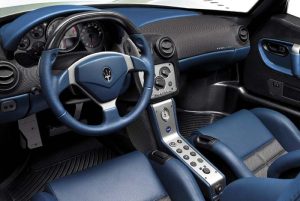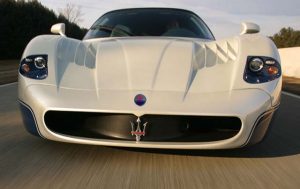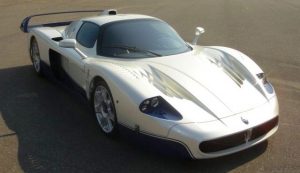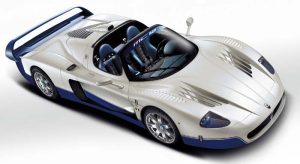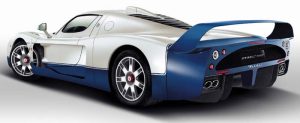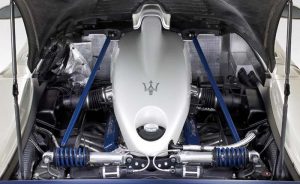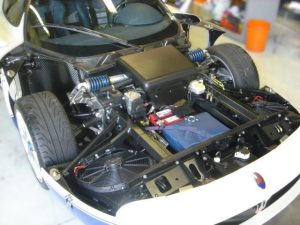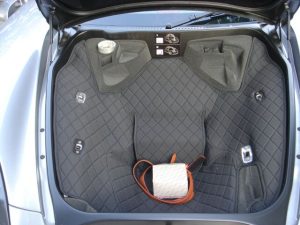
Maserati MC12 (2004 to 2005) has designed a new road-going Grand Tourer known as the MC12 from which a GT racing version has also been developed.
The result is that 37 long years after its last victory in an international championship (1967, Cooper Maserati F1, South African Grand Prix), the Trident is returning to the track.
The Ferrari Maserati Group’s wealth of knowledge and technological excellence have been poured into the design of the new car. In addition to this, its styling was developed in the wind tunnel from a Giugiaro idea by Maserati technicians with the support of Frank Stephenson, the Ferrari Maserati Group’s own Director of Concept Design and Development. The European type-approved version of the new car goes on sale after the summer.
Designed for high level road use, it can exceed 330 km/h (205mph) at full throttle, sprinting from 0 to 100 km/h in just 3.8 seconds. Although easy and pleasant to drive on the road, the MC12 is also a brilliantly dynamic car.
It handles very sweetly and fluidly yet the driver can still feel all the power of a genuinely sporty thoroughbred under the surface. The new model adds the definitive flourish to Maserati’s return to the racing circuits after the recent and highly successful debut in the Daytona 24 Hour Race, of the Trofeo Light, inspired by the equally impressive single-series protagonist. Under the guidance of engineer Giorgio Ascanelli, Maserati’s Racing Division is currently developing the new car to meet the rules of the major international championships.
The client version for road use will be available exclusively in a white and blue livery, harking back to an old Trident tradition. In fact, blue and white are the colours of the America Camoradi (Casner Motor Racing Division) Scuderia which raced the famous Maserati Tipo 60-61 Birdcages in the very early 1960s with Stirling Moss as their lead driver. Around 30 MC12s will be built in all, 25 of which will be for road use.
A second series of 25 examples for clients will be built in 2005 also.
Intensive wind tunnel testing and advanced mathematical computations, combined with work on the track and road, have resulted in an extraordinarily efficient form that absolutely exudes power and personality. The air intakes, vents and other aerodynamic components have been designed to optimise the car’s internal fluid dynamics and air flows to ensure optimal downforce (vertical load) and aerodynamic efficiency values.
The bonnet is characterised by the sinuous lines formed by two large tapering apertures, culminating in the classic Maserati grille opening with a Trident at its centre. The bonnet and wheelarches, into which the Bi-Xenon headlamp units are set, are a one-piece moulding which is also removable
A channel along the side of the car stretches from the front wheel vent to an inlet just in front of the rear wheel. This solution contributes to aerodynamic downforce whilst also improving aerodynamic efficiency.
Above the hard top, there is a snorkel for the engine compartment. The rear section is dominated by the engine and the slender (30 mm) yet imposing two-metre carbon wing with two fins and, at its base, a small spoiler in which the third stop light has been inserted. The inverted half moon design of the exhausts is the most striking part of the tail section. The whole underside of the car has been faired in and sealed and there are two generous diffusers also which deliver maximum “ground effect.”
Interior:
The cabin boasts an easily removable top, which instantly converts the MC12 from a coupé to a spider.
The cabin itself is the epitome of elegance and sportiness. It is simple and understated, typical of an extreme car yet also displaying the meticulous care and finish that have become a classic Trident signature. There is exceptional harmony between the high tech-effect carbon features, the perforated leather trim and the stunning yet high-grip tough technical fabric too.
The upper part of the leather and carbon-trimmed steering wheel is slightly flattened. The dashboard, with its clean tailored lines, is characteristically Maserati. The instruments are organised around a central and prominent speedometer, placed directly in front of the driver. The center console includes the controls for the climate control system, and two of its four vents
Set at the intersection of the console and the central tunnel is the characteristic oval clock, and the blue engine Start button. Other controls are laid out on the titanium-coloured stylised central tunnel which also includes a storage compartment and a 12 volt outlet.
The seats have a carbon fibre structure with high lateral containment: the seats themselves are upholstered in fabric with the shoulder rests in perforated leather. The doors have carbon fibre panels and pockets complete with the electric window buttons. The pedals are aluminium and the mats rubber.
Engine:
The MC12 benefits from all of the Ferrari Maserati Group’s most advanced technologies and competition experience.
It boasts a powerful naturally aspirated 12-cylinder 65° V engine that displaces 5998 cc and punches out 465 kW at 7500 rpm. Designed to meet the specific needs and characteristics of a road-going Maserati, it also offers absolutely excellent drivability.
The MC12 delivers a maximum torque of 652 Nm at 5500 rpm and remains exceptionally nimble and fluid, even at low engine speeds. It has an aluminium crankcase, titanium con rods, and extremely aerodynamically efficient four-valve cylinder heads to boot. Distribution is by way of four overhead camshafts per cylinder which are gear-driven, a solution that offers perfect timing control. The dry sump lubrication also boasts a highly efficient scavenger pump.
The Maserati MC12 is a two-seater long-tail coupé-spider with a long wheel base (2800 mm).
It has a typical racing/sporty set-up with a removable hard top. It is also powered by an impressive 630 hp six-litre mid-rear V12 engine and boasts 41%-front and 59%-rear weight distribution. Highly advanced composites and alloys have enhanced its structural rigidity and kept its overall weight down.
The MC12’s bodywork is entirely carbon fibre, while its stress-bearing chassis is made from a carbon fibre and Nomex honeycomb sandwich. Two aluminium sub-chassis’s support the ancillaries, help absorb bumps, and guarantee an excellent standard of safety.
Transmission:
In line with the MC12’s performance-oriented design, it is supplied exclusively with the six-speed Maserati Cambiocorsa transmission offering computerised gear selection.
The driver does not need to touch the clutch with this electro-hydraulic gearbox and instead selects the gears using the paddles mounted behind the steering wheel. The transmission’s two modes are selected at the touch of a button.
The Sport mode will be the driver’s most frequent choice and includes a good dose of traction control, while the Race setting enhances the kind of sporty behaviour typically seen on the track. In Race mode, in fact, the system delivers much nippier gear changing and activates the ASR also
Suspension:
The MC12 has independent wishbone suspension front and rear with anti-dive and anti-squat geometries and push-rod suspension.
This set-up offers very progressive suspension response for exceptional handling precision under all conditions. The front of the car can be raised for parking ramps and the 19″ wheels are attached via a single centre locking wheel nut. It also boasts Pirelli tyres: 245/35 (front) and 345/35 (rear).
Brakes:
The MC12’s brakes were developed by Brembo.
They deliver maximum braking efficiency and fade resistance, thanks to large ventilated cross-drilled discs (front diameter 380 mm and rear 335 mm). Six and four-piston alloy callipers (front/rear). The MC12 also boasts ABS
ENGINE:
65 V12, Distribution is by way of twin gear-driven overhead camshafts per, cylinder bank, with four valves per cylinder hydraulic tappets., Dry sump engine lubrication with pump in a single unit., Integrated Bosch injection-ignition system, drive-by-wire electronic
PERFORMANCE
- Top speed: . . . . . . . . . . . . . . . . . . . . . . . . . . . . .330 km/h (205mph)
- 0 to 100 km/h acceleration: . . . . . . . . . . . . . . 3.8 s
- 0 a 200 km/h acceleration: . . . . . . . . . . . . . . .9.9 s
- 0-400 metres acceleration: . . . . . . . . . . . . . . 11.3 s
- 0-1000 metres: . . . . . . . . . . . . . . . . . . . . . . . . .20.1 s
MC12 (2004 to 2005)
The 630-hp Maserati MC12 marked Maserati’s return to true supercar territory. Unveiled at the 2004 Geneva motor show, it was a very exclusive mid-engine model originally intended to be limited to just 25 hand-built units, all of which sold-out before its launch even with its $1 million price – proving Maserati to be one of the few companies that can command such a premium. Due to the MC12’s considerable success, immediately followed up with numerous victories in the FIA’s GT1 class, a second batch of 25 cars was built in 2005.
Designed for high level road use, the MC12 exceeded 330 kmh (205 mph) at full throttle, sprinting from 0 to 100 kmh in just 3.8 seconds, making the MC12 the fastest Maserati ever made and part of an exclusive group of street cars able to exceed 200 miles an hour. The MC12 benefited from the Ferrari-Maserati Group’s most advanced technologies and competition experience. Its naturally aspirated 6 liter V12 punched out a massive 465 kW at 7500 rpm yet offered absolutely excellent drivability, remaining exceptionally lively and fluid even at low engine speeds.
An aluminum crankcase, titanium con-rods and extremely efficient four valve cylinder heads were all part of its design. Four gear-driven overhead camshafts provided perfect timing control. The unit was mated to Maserati’s proven six-speed Cambiocorsa transmission, offering computerized gear selection. In Race mode, the system was mapped to deliver much faster gear changes and to activate the ASR.
The MC12’s independent wishbone front and rear suspension with anti-dive and anti-squat geometries and push-rod set-up offered an extremely progressive suspension response for exceptionally precise handling. The stress-bearing chassis was made from a carbon fiber and Nomex honeycomb sandwich, while the two-seater bodywork was constructed entirely from carbon fiber, and featured a removable hard top.
The car’s styling, based an idea originally from Giugiaro, was developed in the wind tunnel by Maserati’s own technicians with the invaluable contribution of Frank Stephenson, then in charge of the Ferrari Maserati Group’s Concept Design and Development department. Intensive wind tunnel testing and advanced mathematical computations, combined with work on the track and on the road, resulted in an extraordinarily efficient shape that exudes power and personality.
All air intakes, vents and other aerodynamic components had been designed to optimize the car’s internal fluid dynamics and air flows to ensure optimal downforce and aerodynamic efficiency values. The whole underside of the car had been faired in and sealed with the fitting of two generous diffusers for maximum ground effect.
Fully homologated in Europe, the MC12 was Maserati’s first mid-engine road-legal GT since 1982. While never Federalized to meet US motor vehicle regulations, and therefore never officially imported into North America, several Maserati enthusiasts privately imported the MC12 into the US and Canada where they have been delighting fans at shows and track days. In June 2004, Maserati’s CEO Martin Leach personally demonstrated the car at the Goodwood Festival of Speed, and among the lucky few worldwide clients was Jason Kay, lead singer of British pop band Jamiroquai.
MC12 Technical Specifications
| Model | MC12 |
| Maserati internal code | |
| Production start | 2004 |
| Number Produced | 50 |
| Ignition | integrated Bosch injection-ignition system |
| Lubrication | dry sump engine lubrication with pump in a single unit |
| Transmission | longitudinal rear-mounted gearbox rigidly connected to engine. Maserati Cambiocorsa mechanical gearbox with electronically controlled electro-hydraulic operation via paddles mounted behind the steering wheel. Dry twin-plate clutch, diameter 215 mm (8.46 inches) with flexible couplings and hydraulic control; Bosch ASR traction control, rear-wheel drive |
| Reduction | 1:4.10 |
| Gear ratios | I=3.15; II=2.18; III=1.57; IV=1.19; V=0.94; VI=0.71 |
| Chassis | Carbon and Nomex honeycomb monocoque chassis with aluminum front and rear sub-frames |
| Front suspension | Double wishbones with push-rod design, progressive-rate steel dampers and coaxial coils & springs |
| Rear suspension | Double wishbones with push-rod design, progressive-rate steel dampers and coaxial coils & springs |
| Brakes | Brembo braking system; brake pad materials: Pagid RS 4.2.1.; Bosch 5.3 ABS anti-blocking system. Electronically controlled braking corrector (EBD). |
| Brakes front | 380 mm x 34 mm (15 inches) cross-drilled ventilating discs, six-piston calipers |
| Brakes rear | 335 mm x 32 mm (13.2 inches) cross-drilled ventilating discs, four-piston calipers with differentiated diameters |
| Steering | rack & pinion, power assisted |
| Cooling system | water-cooled |
| Length | 202.5 inches (5,143 mm) |
| Width | 82.5 inches (2,096 mm) |
| Height | 47.4 inches (1,205 mm) |
| Wheelbase | 110.2 inches (2,800 mm) |
| Front track | 65 inches (1,660 mm) |
| Rear track | 64.9 inches (1,650 mm) |
| Dry weight | 2,943 lbs (1,335 kg) |
| Curb weight | 3,142 lbs (1,425 kg) |
| Tires | Pirelli P Zero Corsa |
| Tires front | 245/35 ZR 19 |
| Tires rear | 345/35 ZR 19 |
| Wheels | 19” light alloy wheels: front 9J x 19, rear 13J x 19 |
| Top speed | 205 mph (330 Km/h) |
| Bodywork | roadster bodywork with removable hard top, two-seater, mid-rear engine |
| Fuel tank | 24.1 Imperial gallons / 30.38 US gallons (115 liters) |
| 0-62 mph | 3.8 sec (0-100 kmh). |
| Standing kilometer | 0 to 1000 m. in 20.1 sec. |
| Production dates | 2004-2005 |
| Engine | 65° V12 |
| Bore and stroke | 92×75.2 mm (3.6×2.95 in.) |
| Total displacement | 5,998 cc (366.02 c.i.) |
| Displacements (unitary) | 449.83 cc (30.5 c.i.) |
| Compression ratio | 11.2:1 |
| Maximum power | 630 hp (465 kW) at 7,500 rpm |
| Maximum torque | 66.5 Kgm / 481 lb-ft (652 Nm) at 5,500 rpm |
| Timing gear | twin gear-driven overhead camshafts per cylinder bank, with four valves per cylinder hydraulic tappets |
| Fuel feed | Bosch injection with electronic control, electronic drive-by-wire throttle control |
| Engine weight | 511.5 lbs (232 kg) |
| Weight distribution | 41% front / 59% rear |

